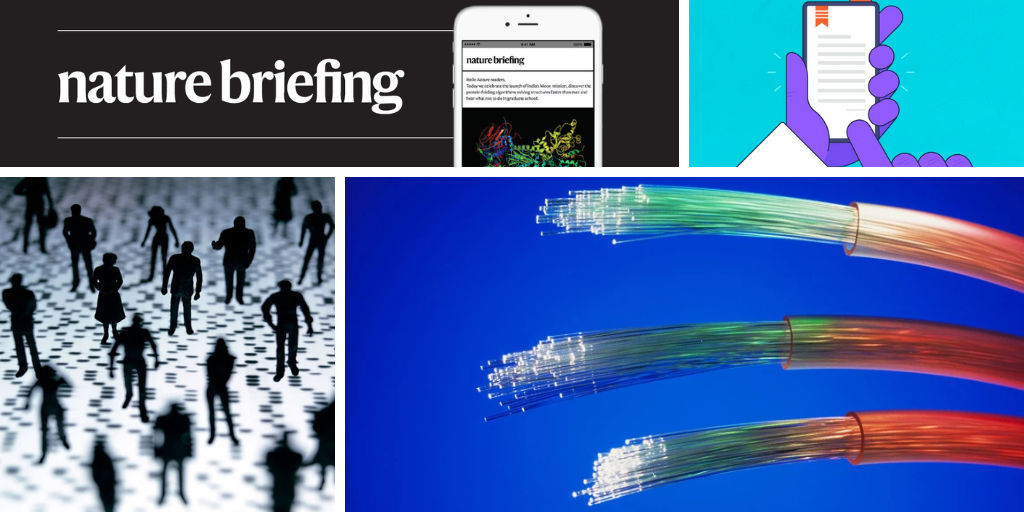You have full access to this article via your institution.
Hello Nature readers, would you like to get this Briefing in your inbox free every day? Sign up here.

Methylation — the addition or removal of tags called methyl groups — of our DNA can change the expression of our genes as we age. (Lawrence Lawry/Science Photo Library)
A huge analysis of epigenetic changes throughout the entire adult lifespan provides the most comprehensive picture to date of how ageing modifies our genes. The study reveals that some human tissues, such as the retina and stomach, accumulate more ageing-related DNA changes than do others, such as the cervix and skin, and found universal epigenetic markers of ageing across different organs. This ‘atlas’ might help researchers to study the link between DNA methylation and ageing and could aid the identification of molecular targets for anti-ageing treatments.
Reference: Research Square preprint (not peer reviewed)
Young Sumatran orangutans (Pongo abelii) pick up the complex nest-building skills of their elders by closely watching their mothers, and later their peers, at work. Researchers found that the infants begin to take an interest at as young as six months old, and must pay attention to learn — simply being around others while they build their nests isn’t enough. Young orangutans also actively practice trickier tasks, such as those required to build a multi-tree nest, after watching them performed, which suggests a desire to learn specific skills.
Reference: Communications Biology paper
A new type of optical fibre that replaces the usual solid-glass wires with a system of hollow glass ‘straws’ could help to make telecommunications systems faster and more efficient. The tubes lose half of the light they transmit every 33 kilometres — around 18 kilometres farther than for standard fibres — which means that the stations used to boost and re-transmit signals could be located farther apart from each other than they are at present. The hollow fibres can also carry the single-photon pulses of visible-spectrum light that are typically used for quantum-communication systems.
Reference: Nature Photonics paper
Features & opinion
A social-media ban for people under 16 in Australia provides a golden opportunity for researchers to investigate how the technology affects adolescents’ mental health, write psychiatric researcher Helen Christensen and biostatistician Andrew Mackinnon. There’s little time to set up the ideal before-and-after experiment, they admit, but previous natural experiments prove that it’s still possible to gather useful data — although results must be treated with caution.
Epidemiologist Katelyn Jetelina, who leads Your Local Epidemiologist, the top paid science newsletter on Substack, turned to the platform after her other social-media accounts got hacked. She likes that the platform allows her to keep control of her subscriber list, and its newsletter-and-blog format promotes a close-knit community of readers. But Substack also has its downsides — it profits from anti-vaccine content and publishes Nazi and white-supremacist newsletters. “It’s the wild, wild west being on Substack,” says Jetelina, “but right now this is the same on any sort of social-media platform.”
How is measuring a quantum state evolving in Hilbert space similar to the ‘Pick Up Song’ game in the long-running British comedy radio show, I’m Sorry I Haven’t a Clue? Glad you asked: theoretical physicist Fay Dowker tells us the answer en route to explaining why the theories of gravity and quantum physics are so fiendishly difficult to reconcile.
Today I’ve got my fingers crossed for Canada’s first commercial space launch, which was delayed mere seconds from lift-off last week. NordSpace aims to demonstrate that a small town in Newfoundland is perfectly placed to launch payloads into low earth orbit from Canadian soil.
While I explore whether I can add ‘launch viewing’ to the itinerary of my upcoming iceberg-spotting trip to The Rock, why not tell me your feedback on this newsletter? Your e-mails are always welcome at [email protected].
Thanks for reading,
Flora Graham, senior editor, Nature Briefing
With contributions by Jacob Smith
• Nature Briefing: Careers — insights, advice and award-winning journalism to help you optimize your working life
• Nature Briefing: Microbiology — the most abundant living entities on our planet — microorganisms — and the role they play in health, the environment and food systems
• Nature Briefing: Anthropocene — climate change, biodiversity, sustainability and geoengineering
• Nature Briefing: AI & Robotics — 100% written by humans, of course
• Nature Briefing: Cancer — a weekly newsletter written with cancer researchers in mind
• Nature Briefing: Translational Research — covers biotechnology, drug discovery and pharma


